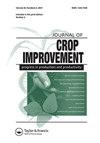Corn yield as affected by row pattern, plant density, and irrigation system
IF 1.5
Q3 AGRONOMY
引用次数: 2
Abstract
ABSTRACT Row crops normally grown in Southeast USA are cotton (Gossypium hirsutum L.), corn (Zea mays L.), and peanut (Arachis hypogea L.) with a focus on the higher economic value for peanut. Peanut is typically planted using a twin-row pattern and purchasing a twin-row planter may not be cost effective unless used with other rotational crops. The objectives were to compare corn yield when planted in twin-rows, with two plant densities, at multiple locations, and irrigated with drip or sprinkler system. Corn was planted in single and twin-row patterns at 7.9 seeds/m (normal; 86,100 seeds/ha) and 4.9 seeds/m (half-normal; 53,600 seeds/ha) at multiple locations and cropping seasons. Irrigation systems consisted of subsurface drip (SSDI), shallow subsurface drip (S3DI) and overhead sprinkler. Single and twin-row with normal seeding rate had same yield across years, locations, or irrigation system 88% of the time. With drip irrigation only, twin-row half-normal seeding rate had the same yield as the single-row normal seeding rate 75% of the time and when factoring in seed savings had an economic benefit of $56/ha. The single-row half-normal seeding rate always had lower yield compared with other treatments. The S3DI irrigation system had greater yield than SSDI for both row patterns and seeding rates. Therefore, a twin-row planter purchased for peanut may be used to plant corn without yield reduction using normal seeding rates under either drip or sprinkler irrigation systems.玉米产量受行距、种植密度和灌溉系统的影响
摘要美国东南部通常种植的行作物有棉花(Gossypium hirsutum L.)、玉米(Zea mays L.)和花生(Arachis hypogea L.),重点是花生具有较高的经济价值。花生通常采用双排模式种植,除非与其他轮作作物一起使用,否则购买双排播种机可能不划算。目的是比较玉米在多个位置种植成两排、两种植物密度以及用滴灌或洒水系统灌溉时的产量。玉米在多个地点和种植季节以7.9种子/m(正常;86100种子/公顷)和4.9种子/m(半正常;53600种子/ha)的单行和双列模式种植。灌溉系统由地下滴灌(SSDI)、浅地下滴灌(S3DI)和高架洒水喷头组成。正常播种率的单列和双列在88%的时间内,在年份、地点或灌溉系统中具有相同的产量。在仅采用滴灌的情况下,双列半正常播种率在75%的时间内与单列正常播种率具有相同的产量,并且考虑到种子节约,经济效益为56美元/公顷。与其他处理相比,单行半正常播种率的产量总是较低。S3DI灌溉系统在行型和播种率方面都比SSDI灌溉系统产量高。因此,为花生购买的双列播种机可以在滴灌或喷灌系统下使用正常播种率种植玉米,而不会减产。
本文章由计算机程序翻译,如有差异,请以英文原文为准。
求助全文
约1分钟内获得全文
求助全文
来源期刊

Journal of Crop Improvement
Multiple-
CiteScore
3.30
自引率
7.70%
发文量
42
期刊介绍:
Journal of Crop Science and Biotechnology (JCSB) is a peer-reviewed international journal published four times a year. JCSB publishes novel and advanced original research articles on topics related to the production science of field crops and resource plants, including cropping systems, sustainable agriculture, environmental change, post-harvest management, biodiversity, crop improvement, and recent advances in physiology and molecular biology. Also covered are related subjects in a wide range of sciences such as the ecological and physiological aspects of crop production and genetic, breeding, and biotechnological approaches for crop improvement.
 求助内容:
求助内容: 应助结果提醒方式:
应助结果提醒方式:


